 The Two Micron All Sky Survey at IPAC
The Two Micron All Sky Survey at IPAC
![]()
 The Two Micron All Sky Survey at IPAC
The Two Micron All Sky Survey at IPAC
|
|
|
 Atlas Image mosaic of our dwarf irregular satellite neighbor, the Large
Magellanic Cloud (LMC; the mosaic has been binned from 1´´ pixels
to 5´´ pixels.)
The LMC is at a distance from us of 50 kpc (or 163,000 light years).
The nebulosity and bright recent star formation seen so prominently in
the optical are much diminished in the near-infrared. Only 30 Doradus
(the Tarantula Nebula) is still relatively recognizable in this image.
The galaxy's bar region, however, is quite prominent, as seen by 2MASS,
as it is dominated by intermediate-age red giants. Also detected in
the galaxy are bright red and blue supergiants, and a large number of
asymptotic giant branch (AGB) stars. In particular, 2MASS is sensitive
to the large quantity of dust-obscured red AGB stars and carbon stars, which
are spatially distributed throughout the galaxy.
Atlas Image mosaic of our dwarf irregular satellite neighbor, the Large
Magellanic Cloud (LMC; the mosaic has been binned from 1´´ pixels
to 5´´ pixels.)
The LMC is at a distance from us of 50 kpc (or 163,000 light years).
The nebulosity and bright recent star formation seen so prominently in
the optical are much diminished in the near-infrared. Only 30 Doradus
(the Tarantula Nebula) is still relatively recognizable in this image.
The galaxy's bar region, however, is quite prominent, as seen by 2MASS,
as it is dominated by intermediate-age red giants. Also detected in
the galaxy are bright red and blue supergiants, and a large number of
asymptotic giant branch (AGB) stars. In particular, 2MASS is sensitive
to the large quantity of dust-obscured red AGB stars and carbon stars, which
are spatially distributed throughout the galaxy.
Image mosaic by E. Kopan (IPAC). (Field size 6.9° × 6.1°.
Image size 967 kb.)
 Atlas Image mosaic of the Small Magellanic Cloud
(SMC), a dwarf irregular galaxy, which, along with the neighboring
Large Magellanic Cloud (LMC), is a satellite of our
own Milky Way Galaxy. Both the LMC and SMC are much smaller in size and mass
than our Galaxy. The SMC, at about 60 kpc, is somewhat farther from us than
the LMC. Compare the 2MASS view with that seen by David Malin in the
optical.
Much of the bar structure can still be seen, and the bright HII region,
NGC 346, is prominent. But, where the light in
the optical is dominated by young, hot stars, the near-infrared light is
dominated by cool, red supergiant and lower-mass red giant stars.
The color-color and
color-magnitude 2MASS
Hess diagrams
show the prevalence of these stars, as well as a number of dust-obscured, red
asymptotic giant branch stars. Also, compare, in particular, the 2MASS SMC
color-magnitude diagram with that found for the LMC using 2MASS by Nikolaev
& Weinberg (2000, ApJ, 542, 804): many of the features are the same, including
the "contamination" by foreground dwarfs and giants, but the detected SMC stars
are correspondingly fainter and fewer in number. The galaxy is so extended
that building this mosaic proved to be quite a challenge! The mosaic is binned
by 2´´ × 2´´ pixels; the JPG rendition has been
further shrunken by a factor of four. Image mosaic by T. Jarrett (IPAC).
(Field size 3.33° × 3.33°. Image size 2.1 Mb!)
Atlas Image mosaic of the Small Magellanic Cloud
(SMC), a dwarf irregular galaxy, which, along with the neighboring
Large Magellanic Cloud (LMC), is a satellite of our
own Milky Way Galaxy. Both the LMC and SMC are much smaller in size and mass
than our Galaxy. The SMC, at about 60 kpc, is somewhat farther from us than
the LMC. Compare the 2MASS view with that seen by David Malin in the
optical.
Much of the bar structure can still be seen, and the bright HII region,
NGC 346, is prominent. But, where the light in
the optical is dominated by young, hot stars, the near-infrared light is
dominated by cool, red supergiant and lower-mass red giant stars.
The color-color and
color-magnitude 2MASS
Hess diagrams
show the prevalence of these stars, as well as a number of dust-obscured, red
asymptotic giant branch stars. Also, compare, in particular, the 2MASS SMC
color-magnitude diagram with that found for the LMC using 2MASS by Nikolaev
& Weinberg (2000, ApJ, 542, 804): many of the features are the same, including
the "contamination" by foreground dwarfs and giants, but the detected SMC stars
are correspondingly fainter and fewer in number. The galaxy is so extended
that building this mosaic proved to be quite a challenge! The mosaic is binned
by 2´´ × 2´´ pixels; the JPG rendition has been
further shrunken by a factor of four. Image mosaic by T. Jarrett (IPAC).
(Field size 3.33° × 3.33°. Image size 2.1 Mb!)
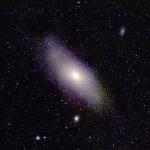 Atlas Image mosaic of Messier 31 (M31), aka the
Andromeda Nebula, or Andromeda Galaxy. This is one of the most famous Messier
objects in the sky, and certainly one of the most famous galaxies. (For the
2MASS view of other Messier objects, please visit the
2MASSier Gallery.) Two additional galaxies,
the much smaller spheroidal objects, are also seen in the 2MASS image mosaic:
Messier 32, to the south, and NGC 205,
to the northwest, which are satellites of the giant spiral M31.
All three are members of the Local Group of galaxies, which includes the Milky
Way, the Large Magellanic Cloud, the Small
Magellanic Cloud, Messier 33, and other
smaller dwarf galaxies. It is through Edwin Hubble's work in the 1920's on
M31, which is at a distance of 765 kpc (2,493,900 light years),
that we first became aware that other galaxies exist beyond the Milky Way.
The Local Group is a gravitationally-bound aggregate
of galaxies, which is a subunit of the much larger Local Supercluster of
groups and galaxy clusters, including the Virgo
Cluster. M31 is so bright and extended on the sky that, at a dark site,
it can be seen with the naked eye. The galaxy is so extended that building
this mosaic proved to be quite a challenge! The M31 field is included in the
Second Incremental Data Release. Image mosaic by T. Jarrett (IPAC).
(Field size 1.42° × 1.42°. Image size 924 kB.)
To obtain a larger, 20 Mb (!) version of the mosaic,
click here.
Atlas Image mosaic of Messier 31 (M31), aka the
Andromeda Nebula, or Andromeda Galaxy. This is one of the most famous Messier
objects in the sky, and certainly one of the most famous galaxies. (For the
2MASS view of other Messier objects, please visit the
2MASSier Gallery.) Two additional galaxies,
the much smaller spheroidal objects, are also seen in the 2MASS image mosaic:
Messier 32, to the south, and NGC 205,
to the northwest, which are satellites of the giant spiral M31.
All three are members of the Local Group of galaxies, which includes the Milky
Way, the Large Magellanic Cloud, the Small
Magellanic Cloud, Messier 33, and other
smaller dwarf galaxies. It is through Edwin Hubble's work in the 1920's on
M31, which is at a distance of 765 kpc (2,493,900 light years),
that we first became aware that other galaxies exist beyond the Milky Way.
The Local Group is a gravitationally-bound aggregate
of galaxies, which is a subunit of the much larger Local Supercluster of
groups and galaxy clusters, including the Virgo
Cluster. M31 is so bright and extended on the sky that, at a dark site,
it can be seen with the naked eye. The galaxy is so extended that building
this mosaic proved to be quite a challenge! The M31 field is included in the
Second Incremental Data Release. Image mosaic by T. Jarrett (IPAC).
(Field size 1.42° × 1.42°. Image size 924 kB.)
To obtain a larger, 20 Mb (!) version of the mosaic,
click here.
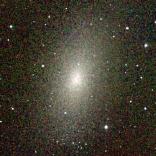 Atlas Image mosaic of NGC 205 (Messier 110), a
dwarf elliptical companion of the giant spiral Andromeda Galaxy (Messier 31;
M31), in the
Local Group of galaxies. NGC 205 is peculiar in that evidence exists for
recent star formation in what nominally should be a galaxy composed of old
stars. The evidence is in the form of centrally-concentrated bright early
type stars, neutral and molecular gas, and dust, much of it in clouds and some
of it very cold (Haas 1998, A&A, 337, L1). From HST imaging,
Cappellari et al. (1999, ApJ, 515, L17) determined that
the quite modest star formation episode occurred over the last 100 million
years; Welch, Sage, & Mitchell (1998, ApJ, 499, 209) found that it ended
only a few million yr ago. Where the star-forming gas originally came from
is a mystery, possibly from interaction with M31 or from the environment of
the M31 system. Image mosaic by S. Van Dyk (IPAC). These data are included
in the Second Incremental Release!
(Field size 11.0´ × 16.8´. Image size 697 kB.)
Atlas Image mosaic of NGC 205 (Messier 110), a
dwarf elliptical companion of the giant spiral Andromeda Galaxy (Messier 31;
M31), in the
Local Group of galaxies. NGC 205 is peculiar in that evidence exists for
recent star formation in what nominally should be a galaxy composed of old
stars. The evidence is in the form of centrally-concentrated bright early
type stars, neutral and molecular gas, and dust, much of it in clouds and some
of it very cold (Haas 1998, A&A, 337, L1). From HST imaging,
Cappellari et al. (1999, ApJ, 515, L17) determined that
the quite modest star formation episode occurred over the last 100 million
years; Welch, Sage, & Mitchell (1998, ApJ, 499, 209) found that it ended
only a few million yr ago. Where the star-forming gas originally came from
is a mystery, possibly from interaction with M31 or from the environment of
the M31 system. Image mosaic by S. Van Dyk (IPAC). These data are included
in the Second Incremental Release!
(Field size 11.0´ × 16.8´. Image size 697 kB.)
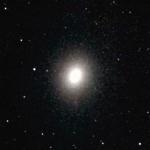 Atlas Image mosaic of the dwarf elliptical galaxy Messier 32 (M32).
M32 is a satellite of the Andromeda Galaxy (Messier 31) and
therefore is also a member of the Local Group of galaxies, which includes the
Milky Way. The proximity of this small early-type galaxy to us has allowed
astronomers to probe its nuclear regions, where there is now a preponderance
of evidence for the presence of a supermassive black hole (with a mass of a
few million solar masses; e.g., Joseph et al. 2001, ApJ, 550, 668),
demonstrating that such black holes appear to reside even in dwarf galaxies.
The mottled appearance of the galaxy in the 2MASS image is due to faint
individual infrared-bright stars. The purplish spot due south of the
nucleus is a known persistence artifact, created by the very bright image
of the galactic nucleus. Image mosaic by S. Van Dyk and R. Hurt (IPAC).
(Field size 8´ × 8´. Image size 204 kB.)
Atlas Image mosaic of the dwarf elliptical galaxy Messier 32 (M32).
M32 is a satellite of the Andromeda Galaxy (Messier 31) and
therefore is also a member of the Local Group of galaxies, which includes the
Milky Way. The proximity of this small early-type galaxy to us has allowed
astronomers to probe its nuclear regions, where there is now a preponderance
of evidence for the presence of a supermassive black hole (with a mass of a
few million solar masses; e.g., Joseph et al. 2001, ApJ, 550, 668),
demonstrating that such black holes appear to reside even in dwarf galaxies.
The mottled appearance of the galaxy in the 2MASS image is due to faint
individual infrared-bright stars. The purplish spot due south of the
nucleus is a known persistence artifact, created by the very bright image
of the galactic nucleus. Image mosaic by S. Van Dyk and R. Hurt (IPAC).
(Field size 8´ × 8´. Image size 204 kB.)
 The Local Group spiral galaxy Messier 33 (M33). M33 is at a distance
from us of about 850 kpc. The spiral arms appear
resplendent in resolved stars and unresolved clusters. The brightest red
clump along the eastern end of the northern arm is the giant H II region
NGC 604; the fainter red clump along this same arm, but just north and west of
the galaxy's nucleus, is the giant H II region NGC 595. These two nebulae are
highlighted in the near-infrared by the red supergiants in the ionizing
stellar associations. Recent massive star formation contributes significantly
to the near-infrared emission from M33. Regan & Vogel (1994, ApJ, 434, 536)
have found that a weak, bar-shaped excess in the stellar mass distribution is
present in the inner 1.5 min of M33, which can also be seen in the 2MASS image,
although it is unclear whether this excess traces the inward extension of the
spiral arms or a true bar. Some of the more diffuse arms in this galaxy are
also faintly seen in this image. The prominent trail of persistence ghost images south
of the brightest foreground star in the image is a known set of artifacts.
Mosaic image construction for M33 by E. Kopan (IPAC).
(Field size 1°.0 × 1°.1. Image size 472 kB.
A smaller, more compressed version [230 kB] is available
here.)
The Local Group spiral galaxy Messier 33 (M33). M33 is at a distance
from us of about 850 kpc. The spiral arms appear
resplendent in resolved stars and unresolved clusters. The brightest red
clump along the eastern end of the northern arm is the giant H II region
NGC 604; the fainter red clump along this same arm, but just north and west of
the galaxy's nucleus, is the giant H II region NGC 595. These two nebulae are
highlighted in the near-infrared by the red supergiants in the ionizing
stellar associations. Recent massive star formation contributes significantly
to the near-infrared emission from M33. Regan & Vogel (1994, ApJ, 434, 536)
have found that a weak, bar-shaped excess in the stellar mass distribution is
present in the inner 1.5 min of M33, which can also be seen in the 2MASS image,
although it is unclear whether this excess traces the inward extension of the
spiral arms or a true bar. Some of the more diffuse arms in this galaxy are
also faintly seen in this image. The prominent trail of persistence ghost images south
of the brightest foreground star in the image is a known set of artifacts.
Mosaic image construction for M33 by E. Kopan (IPAC).
(Field size 1°.0 × 1°.1. Image size 472 kB.
A smaller, more compressed version [230 kB] is available
here.)
 Atlas Image Mosaic of the galaxy IC 10,
a member of the Local Group of galaxies, which includes the Milky Way.
IC 10 is a dwarf irregular galaxy; dwarfs are smaller, as their name implies,
and contain less mass than giant elliptical and spiral galaxies, such as our
own Galaxy. The irregulars have little ordered morphology, are typically
gas-rich, and show evidence for ongoing star formation, i.e., hot, blue stars,
HII regions, and dust. Including the Magellanic Clouds, there are 9 dwarf
irregular out of 35 member galaxies in the Local Group (van den Bergh 1999,
A&ARev, 9, 273). IC 10 is at a
distance of 500-660 kpc (1.6-2.2 million light years; Sakai, Madore, & Freedman
1999, ApJ, 511, 671) and low galactic latitude (b=-3.3°); the high
visual extinction to the galaxy leads to the uncertainty in its distance.
2MASS is not particularly sensitive to dwarf galaxies, due to their generally
low surface brightness. In the case of the Local Group dwarfs, however,
individual stars, e.g., bright carbon and asymptotic giant branch stars, are
resolved and measured by 2MASS.
Image mosaic by S. Van Dyk (IPAC).
(Field size 13.0´ × 13.0´. Image size 542 kB.)
Atlas Image Mosaic of the galaxy IC 10,
a member of the Local Group of galaxies, which includes the Milky Way.
IC 10 is a dwarf irregular galaxy; dwarfs are smaller, as their name implies,
and contain less mass than giant elliptical and spiral galaxies, such as our
own Galaxy. The irregulars have little ordered morphology, are typically
gas-rich, and show evidence for ongoing star formation, i.e., hot, blue stars,
HII regions, and dust. Including the Magellanic Clouds, there are 9 dwarf
irregular out of 35 member galaxies in the Local Group (van den Bergh 1999,
A&ARev, 9, 273). IC 10 is at a
distance of 500-660 kpc (1.6-2.2 million light years; Sakai, Madore, & Freedman
1999, ApJ, 511, 671) and low galactic latitude (b=-3.3°); the high
visual extinction to the galaxy leads to the uncertainty in its distance.
2MASS is not particularly sensitive to dwarf galaxies, due to their generally
low surface brightness. In the case of the Local Group dwarfs, however,
individual stars, e.g., bright carbon and asymptotic giant branch stars, are
resolved and measured by 2MASS.
Image mosaic by S. Van Dyk (IPAC).
(Field size 13.0´ × 13.0´. Image size 542 kB.)
 Atlas Image mosaic of the Local Group dwarf irregular galaxy NGC 6822,
also known as Barnard's Galaxy. Compare
the 2MASS near-infrared image with that in the
optical. The
optical light is dominated by the young, hot, blue stars and HII, or ionized
hydrogen, regions, whereas the view from 2MASS is of the older, more evolved
giant, supergiant, and asymptotic giant branch stars (the nebulae are far
less obvious). These cooler stars better represent the overall mass
distribution in galaxies, even irregular ones.
The distance of NGC 6822 from us is about 500 kpc (1.63 million light years).
(Field size 25´ × 25´. Image size 717 kB.)
Atlas Image mosaic of the Local Group dwarf irregular galaxy NGC 6822,
also known as Barnard's Galaxy. Compare
the 2MASS near-infrared image with that in the
optical. The
optical light is dominated by the young, hot, blue stars and HII, or ionized
hydrogen, regions, whereas the view from 2MASS is of the older, more evolved
giant, supergiant, and asymptotic giant branch stars (the nebulae are far
less obvious). These cooler stars better represent the overall mass
distribution in galaxies, even irregular ones.
The distance of NGC 6822 from us is about 500 kpc (1.63 million light years).
(Field size 25´ × 25´. Image size 717 kB.)
 The giant elliptical galaxy Maffei 1, along with its neighbor
Maffei 2 (below), lie only about
4-5 million parsecs from the Milky Way (approximately 5 times as far as the
Andromeda Galaxy, M31, but in the opposite direction on the sky). However,
because they lie in the plane of the Milky Way, dust from our galaxy veils
these galaxies, rendering them almost invisible at optical
wavelengths. These images, obtained with the northern facility
in 1997 October, illustrate that in the near infrared
the effects of obscuring dust are greatly diminished, revealing the
true brightness and extent of our extragalactic neighbors.
(Field size 10.4´ × 9.9´. Image size 259 kB.)
The giant elliptical galaxy Maffei 1, along with its neighbor
Maffei 2 (below), lie only about
4-5 million parsecs from the Milky Way (approximately 5 times as far as the
Andromeda Galaxy, M31, but in the opposite direction on the sky). However,
because they lie in the plane of the Milky Way, dust from our galaxy veils
these galaxies, rendering them almost invisible at optical
wavelengths. These images, obtained with the northern facility
in 1997 October, illustrate that in the near infrared
the effects of obscuring dust are greatly diminished, revealing the
true brightness and extent of our extragalactic neighbors.
(Field size 10.4´ × 9.9´. Image size 259 kB.)
 Atlas Image of the nearby barred spiral galaxy Maffei 2, which is
located near the Galactic Plane, at galactic longitude l=136.50 and
latitude b=-0.33, and suffers from ~5 magnitudes of visual
extinction. As such, it wasn't recognized as a galaxy until it was initially
detected in the near-infrared as an anomalous source by Maffei (1968. PASP, 80,
618) and its morphological type was identified by Spinrad et al. (1971, ApJ,
163, L25). Maffei 2, at a distance of about 5 Mpc (16.3 million light years),
and its nearby elliptical companion, Maffei 1, highlight the importance of
the near infrared, and, specifically, 2MASS, as a window
on galaxies behind the Milky Way disk in the so-called "Zone of Avoidance",
where they are hidden due to Galactic dust. Although its gas
kinematics are consistent with those of other barred galaxies, Maffei 2 in
the infrared, radio continuum and H I emission appears markedly disturbed.
The structural asymmetries, as well as the nuclear starburst, are possibly
driven by an ongoing merger with a small satellite companion galaxy (Hurt,
Turner, & Ho 1996, ApJ, 466, 135).
These data are part of the First Incremental (Spring 1999) Data Release.
Image mosaic by R. Cutri (IPAC).
(Field size 12.0´ × 14.4´. Image size 153 kB.)
Atlas Image of the nearby barred spiral galaxy Maffei 2, which is
located near the Galactic Plane, at galactic longitude l=136.50 and
latitude b=-0.33, and suffers from ~5 magnitudes of visual
extinction. As such, it wasn't recognized as a galaxy until it was initially
detected in the near-infrared as an anomalous source by Maffei (1968. PASP, 80,
618) and its morphological type was identified by Spinrad et al. (1971, ApJ,
163, L25). Maffei 2, at a distance of about 5 Mpc (16.3 million light years),
and its nearby elliptical companion, Maffei 1, highlight the importance of
the near infrared, and, specifically, 2MASS, as a window
on galaxies behind the Milky Way disk in the so-called "Zone of Avoidance",
where they are hidden due to Galactic dust. Although its gas
kinematics are consistent with those of other barred galaxies, Maffei 2 in
the infrared, radio continuum and H I emission appears markedly disturbed.
The structural asymmetries, as well as the nuclear starburst, are possibly
driven by an ongoing merger with a small satellite companion galaxy (Hurt,
Turner, & Ho 1996, ApJ, 466, 135).
These data are part of the First Incremental (Spring 1999) Data Release.
Image mosaic by R. Cutri (IPAC).
(Field size 12.0´ × 14.4´. Image size 153 kB.)
 Atlas Image mosaic of the nearby
spiral NGC 253, which is a prototypical starburst galaxy. Starburst
galaxies are those that are experiencing intense recent star formation, often
concentrated at a galaxy's nucleus or along the galaxy's spiral arms. The
nucleus of NGC 253 as seen in the 2MASS Image mosaic is a very bright source
of near-infrared emission. Compare the 2MASS image mosaic to an equivalent
large-scale
optical image
of the galaxy. In the near-IR the very prominent and patchy dust lanes seen
in the optical image are far less obvious; the overall light distribution in
the near-IR is smoother, even though the galaxy disk is significantly
inclined. What is obvious in the near-IR is the barred nature of this galaxy
(Forbes & DePoy 1992, A&A, 259, 97; Scoville et al. 1985, ApJ, 289, 129), which
is not as evident in the optical. A number of bright knots of
red supergiant stars and some dusty patchiness are also seen along the arms
and bar. Image mosaic by S. Van Dyk (IPAC).
(Field size 21.0´ × 21.0´.
Image size 1.1 Mb!)
Atlas Image mosaic of the nearby
spiral NGC 253, which is a prototypical starburst galaxy. Starburst
galaxies are those that are experiencing intense recent star formation, often
concentrated at a galaxy's nucleus or along the galaxy's spiral arms. The
nucleus of NGC 253 as seen in the 2MASS Image mosaic is a very bright source
of near-infrared emission. Compare the 2MASS image mosaic to an equivalent
large-scale
optical image
of the galaxy. In the near-IR the very prominent and patchy dust lanes seen
in the optical image are far less obvious; the overall light distribution in
the near-IR is smoother, even though the galaxy disk is significantly
inclined. What is obvious in the near-IR is the barred nature of this galaxy
(Forbes & DePoy 1992, A&A, 259, 97; Scoville et al. 1985, ApJ, 289, 129), which
is not as evident in the optical. A number of bright knots of
red supergiant stars and some dusty patchiness are also seen along the arms
and bar. Image mosaic by S. Van Dyk (IPAC).
(Field size 21.0´ × 21.0´.
Image size 1.1 Mb!)
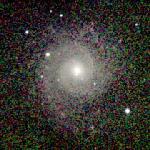 The nearly face-on spiral galaxy NGC 628, aka Messier 74.
(Field size 7.0´ × 7.0´.
Image size 239 kb.)
The nearly face-on spiral galaxy NGC 628, aka Messier 74.
(Field size 7.0´ × 7.0´.
Image size 239 kb.)
 The nearly edge-on Sb galaxy NGC 891, with its conspicuous dust lane,
is often compared to the Milky Way Galaxy, due to its suspected resemblance.
Thus, studying
this galaxy provides insights on the nature of our own Galaxy. Imaging this
galaxy in the near-IR allows us to look deeper through the extinction caused
by the dust and also better map the light and mass distribution of the galaxy,
since
the light from spiral galaxies in the near-IR is dominated by lower-mass stars,
which comprise most of a galaxy's visible mass. This galaxy was previously
imaged in the near-IR by Aoki et al. (1991, PASJ, 43, 755) and Xilouris et al.
(1998, A&A, 331, 894). Aoki et al. found
that the patchy reddish color of the galaxy's disk is not only due to the dust
lanes, but also to the light from late-type supergiants, with a z scale
height of ~350 pc (assuming a distance of 9.8 kpc). From modelling of the
optical and near-IR light, Xilouris et al. find an overall scale height for the
stars of ~400 pc and a scale height for the dust of ~260 pc; the scale length
for stars in the disk is 5.1 kpc, while for the dust, it is 7.5 kpc.
Xilouris et al. conclude that if seen face-on, NGC 891 would be optically
thin, and that from its estimated dust mass and extinction law, this galaxy
is indeed very much like our own Milky Way.
Image mosaic by E. Kopan (IPAC).
(Field size 11.6´ × 15.8´.
Image size 486 kb.)
The nearly edge-on Sb galaxy NGC 891, with its conspicuous dust lane,
is often compared to the Milky Way Galaxy, due to its suspected resemblance.
Thus, studying
this galaxy provides insights on the nature of our own Galaxy. Imaging this
galaxy in the near-IR allows us to look deeper through the extinction caused
by the dust and also better map the light and mass distribution of the galaxy,
since
the light from spiral galaxies in the near-IR is dominated by lower-mass stars,
which comprise most of a galaxy's visible mass. This galaxy was previously
imaged in the near-IR by Aoki et al. (1991, PASJ, 43, 755) and Xilouris et al.
(1998, A&A, 331, 894). Aoki et al. found
that the patchy reddish color of the galaxy's disk is not only due to the dust
lanes, but also to the light from late-type supergiants, with a z scale
height of ~350 pc (assuming a distance of 9.8 kpc). From modelling of the
optical and near-IR light, Xilouris et al. find an overall scale height for the
stars of ~400 pc and a scale height for the dust of ~260 pc; the scale length
for stars in the disk is 5.1 kpc, while for the dust, it is 7.5 kpc.
Xilouris et al. conclude that if seen face-on, NGC 891 would be optically
thin, and that from its estimated dust mass and extinction law, this galaxy
is indeed very much like our own Milky Way.
Image mosaic by E. Kopan (IPAC).
(Field size 11.6´ × 15.8´.
Image size 486 kb.)
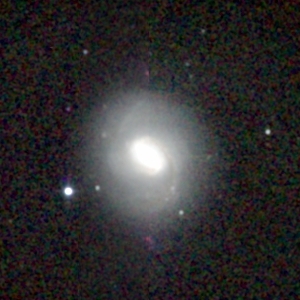 Atlas Image mosaic of the famous Seyfert galaxy Messier
77 (NGC 1068). The nucleus of this galaxy is so bright in the infrared,
particularly at longer wavelengths, that in the 2MASS mosaic, it has created
persistence artifacts, seen as the two red "spots" due north and south of
the galaxy center. (A pair of artifacts are seen, due to the mosaicing of
images made by the two different scan directions.) The bright galactic bar is
apparent in the image, with two or more dusty arms extending outward along the
galaxy disk. Although classified as Seyfert 2, it has been recently speculated
that the nucleus of this well-studied galaxy is actually the prototypical
dust torus-obscured Seyfert 1 nucleus, where a powerful supermassive black
hole is thought to reside. The extinction toward the nucleus may be as high
as 40 visual magnitudes (Lumsden et al. 1999, MNRAS, 303, 209).
The bar is the site of very active star formation, out to
10 kpc radius, and a relationship may exist between the spectacular activity of
the nucleus and the copious gas and new stars around it. Image mosaic by S.
Van Dyk (IPAC). These data are included in the Second Incremental Release!
(Field size 5.0´ × 5.0´.
Image size 123 kB.)
Atlas Image mosaic of the famous Seyfert galaxy Messier
77 (NGC 1068). The nucleus of this galaxy is so bright in the infrared,
particularly at longer wavelengths, that in the 2MASS mosaic, it has created
persistence artifacts, seen as the two red "spots" due north and south of
the galaxy center. (A pair of artifacts are seen, due to the mosaicing of
images made by the two different scan directions.) The bright galactic bar is
apparent in the image, with two or more dusty arms extending outward along the
galaxy disk. Although classified as Seyfert 2, it has been recently speculated
that the nucleus of this well-studied galaxy is actually the prototypical
dust torus-obscured Seyfert 1 nucleus, where a powerful supermassive black
hole is thought to reside. The extinction toward the nucleus may be as high
as 40 visual magnitudes (Lumsden et al. 1999, MNRAS, 303, 209).
The bar is the site of very active star formation, out to
10 kpc radius, and a relationship may exist between the spectacular activity of
the nucleus and the copious gas and new stars around it. Image mosaic by S.
Van Dyk (IPAC). These data are included in the Second Incremental Release!
(Field size 5.0´ × 5.0´.
Image size 123 kB.)
 Atlas Image mosaic of NGC 1097 shows
the prominent bar in this LINER (now Seyfert 1) galaxy. The presence of the
bar may perhaps be due to tidal interaction with the fainter small elliptical
companion galaxy, NGC 1097A, also seen in the image.
In the inset one
can see the very bright well-known circumnuclear ring of gas, dust, and
stars, where intense star formation is occurring around the active nucleus
of NGC 1097.
The ring, both in the optical and in the near-infrared, resolves into
two-armed spirals, which appear to be common in barred galaxies and is in
accord with simulations of bar-driven inflow of gas (Barth et al. 1995, AJ,
110, 1009). Extremely compact young star clusters were found by Barth et al.
along the ring in Hubble Space Telescope imaging. One of the important
questions is the connection between circumnuclear rings and the active nucleus.
Are the gas and stars in the ring feeding the putative supermassive black
hole at the nucleus? The broad optical emission line profiles seen in
1996 by Storchi-Bergmann et al. (1997, ApJ, 489, 87) from the galaxy's nucleus
is consistent with attributing their origin to an accretion disk that has
formed abruptly from the tidal disruption of a star by the black hole.
Image mosaic by S. Van Dyk (IPAC). (Field size 11.9´ × 12.4´.
Image size 569 kB.)
Atlas Image mosaic of NGC 1097 shows
the prominent bar in this LINER (now Seyfert 1) galaxy. The presence of the
bar may perhaps be due to tidal interaction with the fainter small elliptical
companion galaxy, NGC 1097A, also seen in the image.
In the inset one
can see the very bright well-known circumnuclear ring of gas, dust, and
stars, where intense star formation is occurring around the active nucleus
of NGC 1097.
The ring, both in the optical and in the near-infrared, resolves into
two-armed spirals, which appear to be common in barred galaxies and is in
accord with simulations of bar-driven inflow of gas (Barth et al. 1995, AJ,
110, 1009). Extremely compact young star clusters were found by Barth et al.
along the ring in Hubble Space Telescope imaging. One of the important
questions is the connection between circumnuclear rings and the active nucleus.
Are the gas and stars in the ring feeding the putative supermassive black
hole at the nucleus? The broad optical emission line profiles seen in
1996 by Storchi-Bergmann et al. (1997, ApJ, 489, 87) from the galaxy's nucleus
is consistent with attributing their origin to an accretion disk that has
formed abruptly from the tidal disruption of a star by the black hole.
Image mosaic by S. Van Dyk (IPAC). (Field size 11.9´ × 12.4´.
Image size 569 kB.)
 Atlas Image mosaic of the nearby spiral galaxy
NGC 2403. This galaxy is of late Hubble type (ScIII, or Scd), and is a
member of the
Messier 81 (M81) group, at a distance of 3.2 Mpc (10.4 million light
years; Freedman & Madore 1988, ApJ, 332, L63). It has many similarities to
the galaxy
Messier 33 in the Local Group (Garnett et al. 1997, ApJ, 489, 63).
Both galaxies contain a number of giant HII regions and young, massive stars
(Drissen et al. 1999, AJ, 117, 1249). In the near-infrared 2MASS image, these
optically bright regions of recent star formation are highlighted by clusters
of luminous red supergiant stars. Image mosaic by S. Van Dyk (IPAC).
(Field size 11.0´ × 11.0´. Image size 439 kB.)
Atlas Image mosaic of the nearby spiral galaxy
NGC 2403. This galaxy is of late Hubble type (ScIII, or Scd), and is a
member of the
Messier 81 (M81) group, at a distance of 3.2 Mpc (10.4 million light
years; Freedman & Madore 1988, ApJ, 332, L63). It has many similarities to
the galaxy
Messier 33 in the Local Group (Garnett et al. 1997, ApJ, 489, 63).
Both galaxies contain a number of giant HII regions and young, massive stars
(Drissen et al. 1999, AJ, 117, 1249). In the near-infrared 2MASS image, these
optically bright regions of recent star formation are highlighted by clusters
of luminous red supergiant stars. Image mosaic by S. Van Dyk (IPAC).
(Field size 11.0´ × 11.0´. Image size 439 kB.)

The spiral galaxy NGC 2613. These images were obtained during the first
night of operations for the southern facility on Cerro Tololo, Chile.
(Field size 8.4´ × 8.7´. Image size 235 kB.)
 Atlas Image Mosaic of the nearly edge-on Seyfert
2 (NED)
galaxy NGC 2683. This Sb galaxy has a small, very bright nucleus in a
peanut-shaped bulge (see also Luetticke, Dettmar, & Pohlen 2000, A&AS, 145,
405; Merrifield & Kuijken 1999, A&A, 345, L47), with filamentary arms and
dark lanes on one side (as described in the original "Reference Catalog of
Bright Galaxies," de Vaucouleurs & de Vaucouleurs 1964).
Barbon & Capaccioli (1975, A&A, 42, 221) found the dusty
spiral arms of this galaxy to be trailing.
Harris et al. (1985, AJ, 90, 2495) found NGC 2683 to have a
population of globular clusters at least as numerous as that of our Galaxy.
Image mosaic by S. Van Dyk (IPAC).
(Field size 7.0´ × 7.0´. Image size 183 kb.)
Atlas Image Mosaic of the nearly edge-on Seyfert
2 (NED)
galaxy NGC 2683. This Sb galaxy has a small, very bright nucleus in a
peanut-shaped bulge (see also Luetticke, Dettmar, & Pohlen 2000, A&AS, 145,
405; Merrifield & Kuijken 1999, A&A, 345, L47), with filamentary arms and
dark lanes on one side (as described in the original "Reference Catalog of
Bright Galaxies," de Vaucouleurs & de Vaucouleurs 1964).
Barbon & Capaccioli (1975, A&A, 42, 221) found the dusty
spiral arms of this galaxy to be trailing.
Harris et al. (1985, AJ, 90, 2495) found NGC 2683 to have a
population of globular clusters at least as numerous as that of our Galaxy.
Image mosaic by S. Van Dyk (IPAC).
(Field size 7.0´ × 7.0´. Image size 183 kb.)
 Atlas Image Mosaic of the barred spiral galaxy
NGC 2903. These data are part of the First Incremental (Spring 1999)
Data Release.
(Field size 6.7´ × 6.7´. Image size 157 kB.)
Atlas Image Mosaic of the barred spiral galaxy
NGC 2903. These data are part of the First Incremental (Spring 1999)
Data Release.
(Field size 6.7´ × 6.7´. Image size 157 kB.)
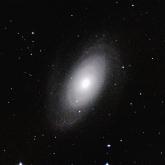 The nearby spiral galaxy Messier 81, aka NGC 3031.
(Field size 20.0´ × 20.0´.
Image size 975 kB.)
The nearby spiral galaxy Messier 81, aka NGC 3031.
(Field size 20.0´ × 20.0´.
Image size 975 kB.)
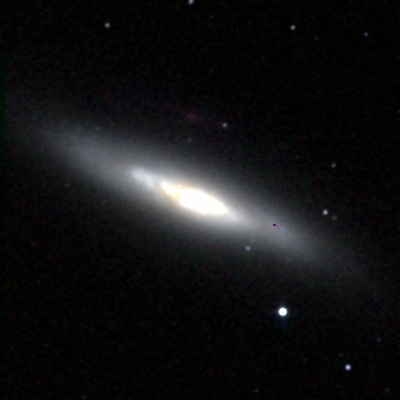 The famous nearby starburst galaxy Messier 82, aka NGC 3034.
(Field size 6.7´ × 6.7´. Image size 128 kB.)
The famous nearby starburst galaxy Messier 82, aka NGC 3034.
(Field size 6.7´ × 6.7´. Image size 128 kB.)
 Atlas Image of NGC 3079, a nearly edge-on
SBc peculiar-type galaxy at a distance of about 18 Mpc (58.7 million light
years). This galaxy exhibits several rather unusual properties: It is
quite dusty, as can even be seen in the 2MASS image; it has a relatively
perturbed morphology; it possesses an active nucleus (AGN); and, it also shows
a superbubble of hot gas emerging from its disk. The superbubble, seen in the
X-rays, radio, and in optical line emission, is driven by a vigorous wind,
thought to arise from the AGN (Cecil et al. 2001, ApJ, 555, 338). Previous
near-infrared high-resolution imaging of the galactic central region by Israel
et al. (1998, A&A, 336, 433) show that the nucleus is obscured by about six
visual magnitudes and confirm that it is surrounded by dense molecular gas.
Image mosaic by S. Van Dyk (IPAC).
(Field size 8´ × 8´. Image size 277 kB.)
Atlas Image of NGC 3079, a nearly edge-on
SBc peculiar-type galaxy at a distance of about 18 Mpc (58.7 million light
years). This galaxy exhibits several rather unusual properties: It is
quite dusty, as can even be seen in the 2MASS image; it has a relatively
perturbed morphology; it possesses an active nucleus (AGN); and, it also shows
a superbubble of hot gas emerging from its disk. The superbubble, seen in the
X-rays, radio, and in optical line emission, is driven by a vigorous wind,
thought to arise from the AGN (Cecil et al. 2001, ApJ, 555, 338). Previous
near-infrared high-resolution imaging of the galactic central region by Israel
et al. (1998, A&A, 336, 433) show that the nucleus is obscured by about six
visual magnitudes and confirm that it is surrounded by dense molecular gas.
Image mosaic by S. Van Dyk (IPAC).
(Field size 8´ × 8´. Image size 277 kB.)
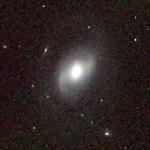 The barred spiral galaxy Messier 96, aka NGC 3368.
(Field size 8´ × 8´. Image size 247 kB.)
The barred spiral galaxy Messier 96, aka NGC 3368.
(Field size 8´ × 8´. Image size 247 kB.)
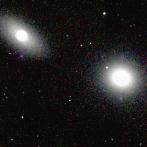 The elliptical galaxy Messier 105, aka NGC 3379.
(Field size 11.5´ × 9.8´. Image size 416 kB.)
The elliptical galaxy Messier 105, aka NGC 3379.
(Field size 11.5´ × 9.8´. Image size 416 kB.)
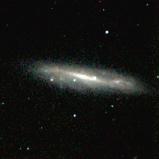
The spiral galaxy Messier 108, aka NGC 3556.
(Field size 8.3´ × 8.3´. Image size 253 kB.)
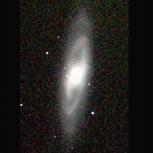
The spiral galaxy Messier 65, aka NGC 3623. (Field size 5.6´ × 11.7´.
Image size 261 kB.)
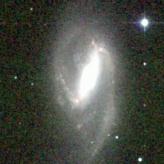
The barred spiral galaxy, Messier 66 (NGC 3627). The red condensations
seen along the spiral arms in this galaxies are sites of active massive star
formation. The red color arises because of intense emission from
excited atomic hydrogen at a wavelength of 2 microns in these regions.
The prominent star forming regions seen at the ends of the bar in this
galaxy are not apparent in visible light images.
(Field size 5.5´ × 10.0´. Image size 207 kB.)
 The spiral galaxy NGC 4189.
(Field size 6.0´ × 6.7´. Image size 175 kb.)
The spiral galaxy NGC 4189.
(Field size 6.0´ × 6.7´. Image size 175 kb.)
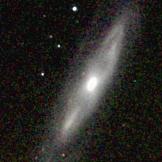
The spiral galaxy Messier 98, aka NGC 4192.
(Field size 6.7´ × 10.4´. Image size 296 kB.)
 The Wolf-Rayet galaxy NGC 4214.
(Field size 6.7´ × 7.5´. Image size 195 kB.)
The Wolf-Rayet galaxy NGC 4214.
(Field size 6.7´ × 7.5´. Image size 195 kB.)
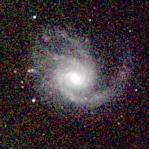
The spiral galaxy Messier 99, aka NGC 4254.
(Field size 6.7´ × 7.5´. Image size 274 kB.)
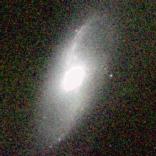
The spiral galaxy Messier 106 (NGC 4258). It is this galaxy for which
water megamasers detected in the radio orbiting very near the galaxy's center
indicate the
presence of a supermassive black hole and allow an accurate kinematical
measurement of the black hole's mass. The masers also allow a precise
geometrical distance to be measured to this galaxy, and this distance is
creating controversy, since it is smaller than the Cepheid distance to the
galaxy, implying a "shorter" distance scale to the Universe than do Cepheid
distances (see Herrnstein et al. 1997, BAAS, 191, 2507).
(Field size 7.2´ × 9.0´. Image size 266 kB.)
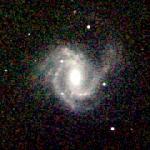
The spiral galaxy Messier 61 (NGC 4303). Note the smooth appearance of
the arms, with knots of massive red supergiant stars seen along the arms.
(Field size 8.2´ × 9.4´. Image size 262 kB.)

The spiral galaxy Messier 100, aka NGC 4321.
(Field size 7.3´ × 9.4´. Image size 311 kB.)
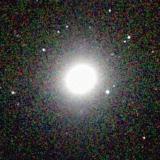
The elliptical galaxy Messier 84, aka NGC 4374.
(Field size 8.6´ × 6.8´. Image size 240 kB.)
 Atlas Image of the barred irregular galaxy
NGC 4449. This galaxy, at a distance of 3.9 Mpc (12.7 million light
years) is about 1.4 times more luminous than the Large Magellanic Cloud and is
forming stars about twice the rate, as seen in the many optically blue stars
and ionized hydrogen in the main body of the galaxy (e.g., Hunter, Walker, &
Wilcots 2000, AJ, 119, 668). In the 2MASS
near-infrared image the bar is evident, as well as several knots of emission
from stellar associations, where large concentrations of massive, evolved
red supergiants exist. The galaxy is unusual, in the amount of extended
neutral hydrogen that envelopes the optical- and near-infrared-bright emission.
(Field size 5.5´ × 5.5´. Image size 151 kB.)
Atlas Image of the barred irregular galaxy
NGC 4449. This galaxy, at a distance of 3.9 Mpc (12.7 million light
years) is about 1.4 times more luminous than the Large Magellanic Cloud and is
forming stars about twice the rate, as seen in the many optically blue stars
and ionized hydrogen in the main body of the galaxy (e.g., Hunter, Walker, &
Wilcots 2000, AJ, 119, 668). In the 2MASS
near-infrared image the bar is evident, as well as several knots of emission
from stellar associations, where large concentrations of massive, evolved
red supergiants exist. The galaxy is unusual, in the amount of extended
neutral hydrogen that envelopes the optical- and near-infrared-bright emission.
(Field size 5.5´ × 5.5´. Image size 151 kB.)
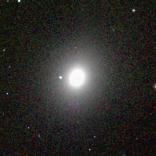 The elliptical galaxy Messier 49 (NGC 4472).
(Field size 8.0´ × 8.0´. Image size 238 kB.)
The elliptical galaxy Messier 49 (NGC 4472).
(Field size 8.0´ × 8.0´. Image size 238 kB.)
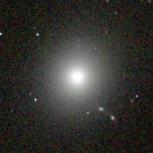
The elliptical radio galaxy Messier 87 (NGC 4486, Virgo A).
Note in the inset the
infrared-bright famous jet emanating to the northwest from the central
supermassive black hole. (Field size 7.5´ × 10.0´.
Image size 290 kB.)
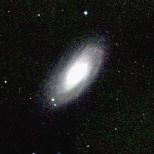
The spiral galaxy Messier 88, aka NGC 4501.
(Field size 9.5´ × 9.4´.
Image size 303 kB.)
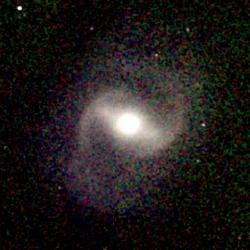
The spiral galaxy Messier 91, aka NGC 4548.
(Field size 5.8´ × 8.3´. Image size 223 kB.)
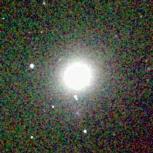
The elliptical galaxy Messier 89, aka NGC 4552.
(Field size 6.3´ × 7.8´. Image size 204 kB.)
 Atlas Image mosaic of the spiral galaxy
NGC 4565. This galaxy, much like other nearby, large edge-on spirals,
such as NGC 5907 and
NGC 891, resemble our Milky Way as
it would be seen edge-on from a distance.
Motivated by a flat rotation curve, implying a total mass of
dark matter of 3.5×1011 M
Atlas Image mosaic of the spiral galaxy
NGC 4565. This galaxy, much like other nearby, large edge-on spirals,
such as NGC 5907 and
NGC 891, resemble our Milky Way as
it would be seen edge-on from a distance.
Motivated by a flat rotation curve, implying a total mass of
dark matter of 3.5×1011 M , Beichman et al. (1999, ApJ, 523, 559), based on deep
Infrared Space
Observatory ISOCAM observations at 4.5 µm, find that the faint
galactic halo likely does not consist of late-M dwarfs distributed spherically,
but could not exclude the presence of lower-luminosity brown dwarf stars.
Image mosaic by S. Van Dyk (IPAC).
(Field size 11.0´ × 11.0´. Image size 389 kB.)
, Beichman et al. (1999, ApJ, 523, 559), based on deep
Infrared Space
Observatory ISOCAM observations at 4.5 µm, find that the faint
galactic halo likely does not consist of late-M dwarfs distributed spherically,
but could not exclude the presence of lower-luminosity brown dwarf stars.
Image mosaic by S. Van Dyk (IPAC).
(Field size 11.0´ × 11.0´. Image size 389 kB.)
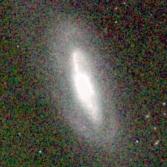
The spiral galaxy Messier 90, aka NGC 4569.
(Field size 6.7´ × 14.2´. Image size 367 kB.)
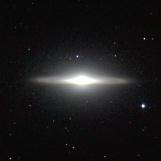 Atlas Image mosaic of the Sombrero, Messier 104 (M104, NGC 4594).
The galaxy derives its nickname from its appearance, as a nearly edge-on
disk system with a "rim" of dark, obscuring dust. The "rim" are the dust
lanes within the disk of this early-type spiral galaxy, which are still
particularly visible, even in this 2MASS near-infrared image. As is true
for other spiral galaxies as seen by 2MASS, the overall apparent structure
of the galaxy is much smoother in the near-infrared than in the optical.
M104 shows an extended halo of emission above and below the plane of the
galaxy's disk. The faint, purplish "stars" emanating both due north and
due south of the galaxy's nucleus are known persistence artifacts.
Image mosaic by S. Van Dyk (IPAC).
These data are included in the Second Incremental Release!
(Field size 9.2´ × 9.2´. Image size 248 kB.)
Atlas Image mosaic of the Sombrero, Messier 104 (M104, NGC 4594).
The galaxy derives its nickname from its appearance, as a nearly edge-on
disk system with a "rim" of dark, obscuring dust. The "rim" are the dust
lanes within the disk of this early-type spiral galaxy, which are still
particularly visible, even in this 2MASS near-infrared image. As is true
for other spiral galaxies as seen by 2MASS, the overall apparent structure
of the galaxy is much smoother in the near-infrared than in the optical.
M104 shows an extended halo of emission above and below the plane of the
galaxy's disk. The faint, purplish "stars" emanating both due north and
due south of the galaxy's nucleus are known persistence artifacts.
Image mosaic by S. Van Dyk (IPAC).
These data are included in the Second Incremental Release!
(Field size 9.2´ × 9.2´. Image size 248 kB.)
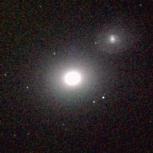 Atlas Image of the giant elliptical galaxy Messier 60 (M60), aka NGC
4649, Arp 116, VV 206. This galaxy is a member of
the Virgo Cluster of galaxies. Like its fellow
Virgo member, the giant elliptical M87,
M60 shows (very weak) jets and radio lobes, indicative of an active nucleus and
the possible presence of a central supermassive black hole of about 1 billion
solar masses (di Matteo & Fabian 1997, MNRAS, 286, L50). The smaller galaxy
to the northeast of NGC 4649 in the 2MASS image is the spiral galaxy NGC 4647.
The small purplish spot just to the north of NGC 4649 is a known persistence
artifact, left temporarily on the 2MASS detectors by the bright nuclear region
of the elliptical galaxy.
(Field size 7.0´ × 7.0´. Image size 191 kB.)
Atlas Image of the giant elliptical galaxy Messier 60 (M60), aka NGC
4649, Arp 116, VV 206. This galaxy is a member of
the Virgo Cluster of galaxies. Like its fellow
Virgo member, the giant elliptical M87,
M60 shows (very weak) jets and radio lobes, indicative of an active nucleus and
the possible presence of a central supermassive black hole of about 1 billion
solar masses (di Matteo & Fabian 1997, MNRAS, 286, L50). The smaller galaxy
to the northeast of NGC 4649 in the 2MASS image is the spiral galaxy NGC 4647.
The small purplish spot just to the north of NGC 4649 is a known persistence
artifact, left temporarily on the 2MASS detectors by the bright nuclear region
of the elliptical galaxy.
(Field size 7.0´ × 7.0´. Image size 191 kB.)
 The barred spiral galaxy NGC 4654.
(Field size 8.3´ × 8.3´. Image size 273 kb.)
The barred spiral galaxy NGC 4654.
(Field size 8.3´ × 8.3´. Image size 273 kb.)
 The spiral galaxy NGC 4689.
(Field size 6.7´ × 6.7´. Image size 209 kb.)
The spiral galaxy NGC 4689.
(Field size 6.7´ × 6.7´. Image size 209 kb.)
 The spiral galaxy NGC 4710.
(Field size 7.5´ × 7.5´. Image size 215 kb.)
The spiral galaxy NGC 4710.
(Field size 7.5´ × 7.5´. Image size 215 kb.)
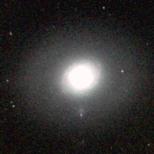
The spiral galaxy Messier 94, aka NGC 4736.
(Field size 7.2´ × 10.0´. Image size 252 kB.)
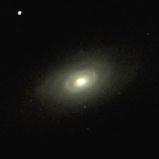
The spiral galaxy Messier 64 (NGC 4826), aka, the "Black Eye" or "Evil
Eye" galaxy. The reddish arc above the
nucleus of this galaxy is caused by a ring of dust that obscures the light
from the underlying stars.
(Field size 8.3´ × 8.9´. Image size 102 kB.)
 Atlas Image Mosaic
of the infrared-luminous galaxy NGC 4945. Throughout the sky are a
number of galaxies that are very luminous in the infrared
(the luminosity LFar-IR>1010
L
Atlas Image Mosaic
of the infrared-luminous galaxy NGC 4945. Throughout the sky are a
number of galaxies that are very luminous in the infrared
(the luminosity LFar-IR>1010
L , based on IRAS measurements).
These galaxies are now understood as experiencing vigorous star formation,
from follow-up observations at optical and other wavelengths. Understanding
this star formation at both high and low redshifts, and its relation
to possible nuclear activity in these galaxies, is currently an important
astronomical problem. The nuclear activity in galaxies is thought to be due
to accretion by a supermassive central black hole. A prime example of a nearby
luminous galaxy is the nearly edge-on barred NGC 4945. Prominent dust lanes
can be seen in the 2MASS image, along the inner bar in the bottom half and along
the outer spiral arm in the top half. This apparent asymmetry is a geometric
effect, as the dust lanes lie along the leading edge of the bar and along the
trailing edge of the spiral arms; at the point of galactic corotation, where
the arms join the bar, the dust lanes switch sides. The nucleus of NGC 4945 is
the brightest infrared source in the south, after the Magellanic Clouds.
Spectra of the nucleus in the near-infrared show a mixture of Seyfert and
starburst phenomena (Moorwood & Oliva 1994, ApJ, 429, 602), as well as evidence
for activity at a range of wavelengths. Lipari, Tsvetanov, & Macchetto (1997,
ApJS, 111, 369) recently made a
comparison of the nucleus' optical and near-IR appearance, and find a distinct
spatial offset; their conclusion is the active nucleus is dust-obscured and
possibly fed by a nuclear starburst, which is driving a superwind, seen in
emission at optical wavelengths. Image mosaic by R. Hurt (IPAC).
(Field size 12.0´ × 12.0´. Image size 437 kB.)
, based on IRAS measurements).
These galaxies are now understood as experiencing vigorous star formation,
from follow-up observations at optical and other wavelengths. Understanding
this star formation at both high and low redshifts, and its relation
to possible nuclear activity in these galaxies, is currently an important
astronomical problem. The nuclear activity in galaxies is thought to be due
to accretion by a supermassive central black hole. A prime example of a nearby
luminous galaxy is the nearly edge-on barred NGC 4945. Prominent dust lanes
can be seen in the 2MASS image, along the inner bar in the bottom half and along
the outer spiral arm in the top half. This apparent asymmetry is a geometric
effect, as the dust lanes lie along the leading edge of the bar and along the
trailing edge of the spiral arms; at the point of galactic corotation, where
the arms join the bar, the dust lanes switch sides. The nucleus of NGC 4945 is
the brightest infrared source in the south, after the Magellanic Clouds.
Spectra of the nucleus in the near-infrared show a mixture of Seyfert and
starburst phenomena (Moorwood & Oliva 1994, ApJ, 429, 602), as well as evidence
for activity at a range of wavelengths. Lipari, Tsvetanov, & Macchetto (1997,
ApJS, 111, 369) recently made a
comparison of the nucleus' optical and near-IR appearance, and find a distinct
spatial offset; their conclusion is the active nucleus is dust-obscured and
possibly fed by a nuclear starburst, which is driving a superwind, seen in
emission at optical wavelengths. Image mosaic by R. Hurt (IPAC).
(Field size 12.0´ × 12.0´. Image size 437 kB.)

The peculiar giant radio galaxy Centaurus A (NGC 5128), the nearest such
galaxy to the Milky Way. Centaurus A is thought to have been the merger of
a small spiral galaxy with a giant elliptical. The infrared morphology is
dominated by a bright nucleus and a dust lane from a thin warped disk.
Modelling of the disk results in a scenario where the spiral was tidally
stripped during its infall (Quillen, Graham, & Frogel 1993, ApJ, 412, 550).
Quillen et al. found elongations in the J and H isophotes near the nucleus,
which they interpret as an IR jet. Individual star clusters have been
identified by Alonso & Minniti (1997, ApJ, 109, 397) from near-IR imaging.
(Field size 8.5´ × 11.7´. Image size 290 kB.)
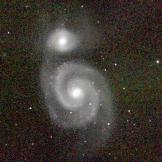 The spiral galaxy, NGC 5194, and its companion, NGC 5195, known together
as Messier 51 (the "Whirlpool Nebula," or "Whirlpool Galaxy").
These two galaxies are nearly
9 million light years from the Milky Way. This image was acquired by the
northern facility in normal survey scanning mode on 1997 April 18 UT, the
first night of operation. 2MASS is most sensitive to light that originates
from the smoothly distributed, relatively old stars in galaxies,
such as M51, which trace the distribution of stellar mass. However, sites of
active massive star formation can also be seen as the knots in the spiral arms
and around the nucleus of the galaxy.
Note that NGC 5195 does not have star-forming regions in its disk; also note
the central bar.
(Field size 13.4´ × 13.4´. Image size 652 kB.)
The spiral galaxy, NGC 5194, and its companion, NGC 5195, known together
as Messier 51 (the "Whirlpool Nebula," or "Whirlpool Galaxy").
These two galaxies are nearly
9 million light years from the Milky Way. This image was acquired by the
northern facility in normal survey scanning mode on 1997 April 18 UT, the
first night of operation. 2MASS is most sensitive to light that originates
from the smoothly distributed, relatively old stars in galaxies,
such as M51, which trace the distribution of stellar mass. However, sites of
active massive star formation can also be seen as the knots in the spiral arms
and around the nucleus of the galaxy.
Note that NGC 5195 does not have star-forming regions in its disk; also note
the central bar.
(Field size 13.4´ × 13.4´. Image size 652 kB.)
 Atlas Image mosaic of the barred spiral galaxy
Messier 83 (NGC 5236). This bright southern galaxy is seen nearly
face-on
and is one of the nearest large barred galaxies to the Milky Way. The bulge
region of this galaxy is experiencing an intense starburst; the structure of
this burst of circumnuclear star formation at high spatial resolution in the
near-infrared, and other wavelengths, is complex (Gallais et al. 1992, A&A,
243, 309). A prominent dust lane emanates in both directions along the bar
and out along the spiral arms. Although the overall appearance of the galaxy
is quite smooth in the near-infrared (e.g, Adamson, Adams, & Warwick 1987,
MNRAS, 224, 367), compared to its appearance in the
optical, a large number of bright knots are seen along the arms, corresponding
to clusters of red (supergiant) stars in and near the many OB stellar
associations and H II regions. Clearly, star formation is happening today not
only in the nucleus, but all over M83. This galaxy has been host to six
historical supernovae, four of which are thought to arise from young, massive
stellar progenitors, both near the nucleus and in the spiral arms, further
evidence for the vigorous galactic star formation. Image mosaic by S. Van Dyk
(IPAC).
(Field size 10.0´ × 10.0´.
Image size 318 kB.)
Atlas Image mosaic of the barred spiral galaxy
Messier 83 (NGC 5236). This bright southern galaxy is seen nearly
face-on
and is one of the nearest large barred galaxies to the Milky Way. The bulge
region of this galaxy is experiencing an intense starburst; the structure of
this burst of circumnuclear star formation at high spatial resolution in the
near-infrared, and other wavelengths, is complex (Gallais et al. 1992, A&A,
243, 309). A prominent dust lane emanates in both directions along the bar
and out along the spiral arms. Although the overall appearance of the galaxy
is quite smooth in the near-infrared (e.g, Adamson, Adams, & Warwick 1987,
MNRAS, 224, 367), compared to its appearance in the
optical, a large number of bright knots are seen along the arms, corresponding
to clusters of red (supergiant) stars in and near the many OB stellar
associations and H II regions. Clearly, star formation is happening today not
only in the nucleus, but all over M83. This galaxy has been host to six
historical supernovae, four of which are thought to arise from young, massive
stellar progenitors, both near the nucleus and in the spiral arms, further
evidence for the vigorous galactic star formation. Image mosaic by S. Van Dyk
(IPAC).
(Field size 10.0´ × 10.0´.
Image size 318 kB.)
 The face-on spiral galaxy NGC 5247.
(Field size 13.3´ × 12.5´. Image size 306 kB.)
The face-on spiral galaxy NGC 5247.
(Field size 13.3´ × 12.5´. Image size 306 kB.)
 Atlas Image of NGC 5253, a dwarf
galaxy of Hubble type S0/I0 and member of the Centaurus group of galaxies,
along with Messier 83 and
Centaurus A (NGC 5128). Although the
extended light of the galaxy is essentially characterized by a dwarf spheroidal
(or S0), NGC 5253 is highlighted by many recently-formed star clusters within
the central 100 pc (Calzetti et al. 1997, AJ, 114, 1834). These clusters
contain a large number of massive stars, including Wolf-Rayet stars; the
integrated light of these very massive, evolved stars leads to the designation
for NGC 5253 as a "Wolf-Rayet galaxy" (Conti 1991, ApJ, 377, 115).
In the 2MASS near-infrared image the galaxy looks significantly different from
optical images. The infrared light, from near- to far-, is dominated by the
emission from a "supernebula" (seen in the 2MASS image as the brightest knot
just northeast of the galaxy center). This object is also a bright thermal
radio source (Turner, Beck, & Ho 2000, ApJ, 532, L109). Gorjian, Turner, &
Beck (2001, ApJ, 554, L29) recently studied the supernebula in the mid-infrared
with the Keck 10-m telescope, and determined that it is excited by
105-106 stars, with the size and mass of a typical
globular cluster, such as 47 Tucanae in
the Milky Way. However, this cluster is very dust-obscured and likely very
young, possibly the youngest known globular cluster in any galaxy.
(Field size 5.5´ × 5.5´. Image size 142 kB.)
Atlas Image of NGC 5253, a dwarf
galaxy of Hubble type S0/I0 and member of the Centaurus group of galaxies,
along with Messier 83 and
Centaurus A (NGC 5128). Although the
extended light of the galaxy is essentially characterized by a dwarf spheroidal
(or S0), NGC 5253 is highlighted by many recently-formed star clusters within
the central 100 pc (Calzetti et al. 1997, AJ, 114, 1834). These clusters
contain a large number of massive stars, including Wolf-Rayet stars; the
integrated light of these very massive, evolved stars leads to the designation
for NGC 5253 as a "Wolf-Rayet galaxy" (Conti 1991, ApJ, 377, 115).
In the 2MASS near-infrared image the galaxy looks significantly different from
optical images. The infrared light, from near- to far-, is dominated by the
emission from a "supernebula" (seen in the 2MASS image as the brightest knot
just northeast of the galaxy center). This object is also a bright thermal
radio source (Turner, Beck, & Ho 2000, ApJ, 532, L109). Gorjian, Turner, &
Beck (2001, ApJ, 554, L29) recently studied the supernebula in the mid-infrared
with the Keck 10-m telescope, and determined that it is excited by
105-106 stars, with the size and mass of a typical
globular cluster, such as 47 Tucanae in
the Milky Way. However, this cluster is very dust-obscured and likely very
young, possibly the youngest known globular cluster in any galaxy.
(Field size 5.5´ × 5.5´. Image size 142 kB.)
 The spiral galaxy Messier 101, aka NGC 5457.
(Field size 8´ × 8´. Image size 744 kB.)
The spiral galaxy Messier 101, aka NGC 5457.
(Field size 8´ × 8´. Image size 744 kB.)
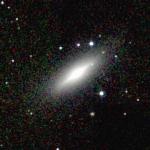 Atlas Image mosaic of the lenticular (S0) galaxy, Messier 102 (M102).
Or is it??? As the
Students for the Exploration
and Development of Space (SEDS) page indicates, M102 is the most
mysterious of the Messier objects. It is thought that the designation is
either a 'bookkeeping' error made by Charles Messier, being a duplicate
referral to
the giant spiral M101, or it refers to this
early-type lenticular galaxy, NGC 5866, aka the Spindle Galaxy. Lenticular,
or S0, galaxies are intermediate in Hubble type to elliptical galaxies, such
as M87, and early-type spiral galaxies, such as
M31, in that the light from S0's is dominated by
a large bulge of old stars, and yet these galaxies also possess a stellar
disk, like spirals, although the prominent spiral arms seen in spiral galaxies
are no longer prominent in S0's. (The smooth near-infrared light seen in the
2MASS image is dominated by the old stars in both the bulge and disk of the
Spindle.) The properties of S0 galaxies, like the true identity of M102, will
likely be a subject of intense study by astronomers into the future.
Image mosaic by S. Van Dyk (IPAC).
(Field size 7´ × 7´. Image size 217 kB.)
Atlas Image mosaic of the lenticular (S0) galaxy, Messier 102 (M102).
Or is it??? As the
Students for the Exploration
and Development of Space (SEDS) page indicates, M102 is the most
mysterious of the Messier objects. It is thought that the designation is
either a 'bookkeeping' error made by Charles Messier, being a duplicate
referral to
the giant spiral M101, or it refers to this
early-type lenticular galaxy, NGC 5866, aka the Spindle Galaxy. Lenticular,
or S0, galaxies are intermediate in Hubble type to elliptical galaxies, such
as M87, and early-type spiral galaxies, such as
M31, in that the light from S0's is dominated by
a large bulge of old stars, and yet these galaxies also possess a stellar
disk, like spirals, although the prominent spiral arms seen in spiral galaxies
are no longer prominent in S0's. (The smooth near-infrared light seen in the
2MASS image is dominated by the old stars in both the bulge and disk of the
Spindle.) The properties of S0 galaxies, like the true identity of M102, will
likely be a subject of intense study by astronomers into the future.
Image mosaic by S. Van Dyk (IPAC).
(Field size 7´ × 7´. Image size 217 kB.)

The edge-on spiral galaxy NGC 5907. Notice the red dust lane
produced by the disk of this galaxy.
(Field size 8.3´ × 10.8´. Image size 272 kB.)
 The barred spiral galaxy NGC 6181.
(Field size 5.8´ × 5.8´. Image size 151 kb.)
The barred spiral galaxy NGC 6181.
(Field size 5.8´ × 5.8´. Image size 151 kb.)

The barred spiral galaxy NGC 6339. This image was made from 10
individual cross-scan test images, which were coadded together, and therefore
represents a total exposure time of nearly 80 seconds. The signal-to-noise in
the image, then, is improved by about a factor of 3 over a single scan image.
The low surface brightness spiral arms of this galaxy are more apparent in
this combined image than in a single scan.
(Field size 7.8´ × 8.3´. Image size 240 kB.)

The nuclear starburst galaxy NGC 6946. Note the numerous red stellar
associations around the nucleus and within the spiral arms of this galaxy. The
arms appear much smoother in the near-infrared than in the optical.
(Field size 8.2´ × 10.8´. Image size 298 kB.)
 Atlas Image mosaic of the spiral galaxy NGC 7331
and its apparent neighbors. The recessional velocity of NGC 7331 is only 816
km/sec, while the velocities for the other galaxies in the 2MASS mosaic range
from 6315 to 8800 km/sec for NGC 7335, 7336, 7337, and 7340 (in increasing
eastward distance from NGC 7331). The highly-inclined NGC 7331, at a
distance of 15.1 Mpc, determined using Cepheid variables by Hughes et al.
(1998, ApJ, 501, 32), is of Hubble
type Sb and has a weak LINER nucleus. "LINER" is low-ionization nuclear
emission region and is a characteristic of low-luminosity active galactic
nuclei, which are thought to harbor supermassive black holes. Evidence for a
nuclear black hole in NGC 7331 was recently reinforced by a ROSAT X-ray
detection of a bright source (Stockdale, Romanishin, & Cowan 1998, ApJ, 508,
L33). The spiral arms, bulge, and extended disk are evident in the 2MASS
image. The disk, in fact, contributes only in a minor way to the mass
content of NGC 7331 (Bottema 1999, A&A, 348, 77).
Molecular hydrogen is the dominant mass contributor to the
interstellar medium in the galaxy's bulge and in a ringlike zone at a distance
of ~3.5 kpc from the center; far-infrared emission from dust peaks inside the
ring at 100 µm (warm dust), and in the ring at 85 µm (colder dust;
Israel & Baas 1999, A&A, 351, 10; Bianchi et al. 1998, MNRAS, 298, L49).
The overall far-infrared luminosity of NGC 7331 is similar to that of our
Milky Way Galaxy. Image mosaic by E. Kopan (IPAC). These data are
included in the Second Incremental Release!
(Field size 13.0´ × 13.0´. Image size 571 kB.)
Atlas Image mosaic of the spiral galaxy NGC 7331
and its apparent neighbors. The recessional velocity of NGC 7331 is only 816
km/sec, while the velocities for the other galaxies in the 2MASS mosaic range
from 6315 to 8800 km/sec for NGC 7335, 7336, 7337, and 7340 (in increasing
eastward distance from NGC 7331). The highly-inclined NGC 7331, at a
distance of 15.1 Mpc, determined using Cepheid variables by Hughes et al.
(1998, ApJ, 501, 32), is of Hubble
type Sb and has a weak LINER nucleus. "LINER" is low-ionization nuclear
emission region and is a characteristic of low-luminosity active galactic
nuclei, which are thought to harbor supermassive black holes. Evidence for a
nuclear black hole in NGC 7331 was recently reinforced by a ROSAT X-ray
detection of a bright source (Stockdale, Romanishin, & Cowan 1998, ApJ, 508,
L33). The spiral arms, bulge, and extended disk are evident in the 2MASS
image. The disk, in fact, contributes only in a minor way to the mass
content of NGC 7331 (Bottema 1999, A&A, 348, 77).
Molecular hydrogen is the dominant mass contributor to the
interstellar medium in the galaxy's bulge and in a ringlike zone at a distance
of ~3.5 kpc from the center; far-infrared emission from dust peaks inside the
ring at 100 µm (warm dust), and in the ring at 85 µm (colder dust;
Israel & Baas 1999, A&A, 351, 10; Bianchi et al. 1998, MNRAS, 298, L49).
The overall far-infrared luminosity of NGC 7331 is similar to that of our
Milky Way Galaxy. Image mosaic by E. Kopan (IPAC). These data are
included in the Second Incremental Release!
(Field size 13.0´ × 13.0´. Image size 571 kB.)
 The barred spiral galaxy NGC 7479.
(Field size 4.0´ × 3.8´. Image size 90 kb.)
The barred spiral galaxy NGC 7479.
(Field size 4.0´ × 3.8´. Image size 90 kb.)

The edge-on spiral LINER galaxy NGC 7814. This galaxy has an appearance
very similar to the famous "Sombrero" galaxy (M104; NGC 4594). A factor which
complicates the study of edge-on galaxies is extinction, due to dust, in the
disk. Fortunately, this extinction, though not zero, is much smaller at
near-IR wavelengths. Imaging NGC 7814 in the near-IR with 2MASS allows a
satisfactory decomposition of the bulge and disk in the galaxy and
the determination of the fundamental characteristics of both components
(Peletier & Knapen 1992, Messenger, 70, 57).
(Field size 8.5´ × 13.3´. Image size 463 kB.)
 Atlas Image mosaic of the galaxy system IC 2554,
which is comprised of three late-type galaxies, components A, B, and C. The
disturbed morphology of this system implies that the galaxies are
gravitationally interacting or merging with one another. The system, aka
IRAS 10075-6647, is also infrared-luminous, indicating possible vigorous
ongoing star formation as a result of the interaction.
The system is seen at only about 9° below the Galactic plane and is at a
distance of about 23 Mpc (75 million light years) from us, for a
distance scale of 65 km/s/Mpc (based on the system's recession velocity from
NED).
(Field size 5´ × 5´. Image size 128 kB.)
Atlas Image mosaic of the galaxy system IC 2554,
which is comprised of three late-type galaxies, components A, B, and C. The
disturbed morphology of this system implies that the galaxies are
gravitationally interacting or merging with one another. The system, aka
IRAS 10075-6647, is also infrared-luminous, indicating possible vigorous
ongoing star formation as a result of the interaction.
The system is seen at only about 9° below the Galactic plane and is at a
distance of about 23 Mpc (75 million light years) from us, for a
distance scale of 65 km/s/Mpc (based on the system's recession velocity from
NED).
(Field size 5´ × 5´. Image size 128 kB.)
 Atlas Image mosaic of the Circinus Galaxy.
This spiral
galaxy, in the constellation Circinus, is relatively nearby, at only 4 Mpc (13
million light years), and is seen through a window of low extinction (only
about 1.5 visual magnitudes) near the Galactic Plane. Observations in the
optical, X-rays, and radio indicate that Circinus has a Seyfert 2 nucleus,
that is, the galaxy is harboring a supermassive black hole at its center.
Storchi-Bergmann et al. (1999, MNRAS, 304, 35) find from near-infrared
spectroscopy of the nucleus evidence for an aging starburst. A dark dust lane,
running to the south and east of the nucleus, is apparent in the 2MASS image;
the disk of the galaxy, overall, is much fainter than the bright nucleus.
Maiolino et al. (2000, ApJ, 531, 219) propose, based on Hubble Space Telescope
near-infrared NICMOS imaging, that this dust lane traces a
nuclear gas bar that may be responsible for feeding the active nucleus; their
imaging indicates that star formation in the nuclear region is still ongoing,
as gas flows inward to the black hole, and points to a complex nuclear star
formation history. Image mosaic by S. Van Dyk (IPAC).
(Field size 8.3´ × 17.1´. Image size 468 kb.)
Atlas Image mosaic of the Circinus Galaxy.
This spiral
galaxy, in the constellation Circinus, is relatively nearby, at only 4 Mpc (13
million light years), and is seen through a window of low extinction (only
about 1.5 visual magnitudes) near the Galactic Plane. Observations in the
optical, X-rays, and radio indicate that Circinus has a Seyfert 2 nucleus,
that is, the galaxy is harboring a supermassive black hole at its center.
Storchi-Bergmann et al. (1999, MNRAS, 304, 35) find from near-infrared
spectroscopy of the nucleus evidence for an aging starburst. A dark dust lane,
running to the south and east of the nucleus, is apparent in the 2MASS image;
the disk of the galaxy, overall, is much fainter than the bright nucleus.
Maiolino et al. (2000, ApJ, 531, 219) propose, based on Hubble Space Telescope
near-infrared NICMOS imaging, that this dust lane traces a
nuclear gas bar that may be responsible for feeding the active nucleus; their
imaging indicates that star formation in the nuclear region is still ongoing,
as gas flows inward to the black hole, and points to a complex nuclear star
formation history. Image mosaic by S. Van Dyk (IPAC).
(Field size 8.3´ × 17.1´. Image size 468 kb.)
 Atlas Image mosaic of the interacting galaxies NGC 4038 and
NGC 4039, better known as the Antennae, or Ring Tail galaxies. The two
galaxies are engaged in a tug-of-war as they collide. The mutual gravitation
between them is working to distort each spiral galaxy's appearance as the two
merge. The interaction is evidently impetus for an intense burst of
new star formation, as can be seen from the many infrared-bright knots and
bright galactic nuclei. Compare the 2MASS view of this system with that
obtained by the Hubble Space Telescope in the
optical. Many of the same features are seen, although 2MASS is able to
peer through much of the dust seen in the galaxies' disks. The galaxy light
looks smoother. Also, in the near-infrared the bright knots of star formation
are likely highlighted by the light of massive red supergiant stars. The much
more extended "tidal tails," which give the Antennae their name, are quite
faint in the 2MASS image mosaic.
(Field size 7´ × 7´. Image size 468 kb.)
Atlas Image mosaic of the interacting galaxies NGC 4038 and
NGC 4039, better known as the Antennae, or Ring Tail galaxies. The two
galaxies are engaged in a tug-of-war as they collide. The mutual gravitation
between them is working to distort each spiral galaxy's appearance as the two
merge. The interaction is evidently impetus for an intense burst of
new star formation, as can be seen from the many infrared-bright knots and
bright galactic nuclei. Compare the 2MASS view of this system with that
obtained by the Hubble Space Telescope in the
optical. Many of the same features are seen, although 2MASS is able to
peer through much of the dust seen in the galaxies' disks. The galaxy light
looks smoother. Also, in the near-infrared the bright knots of star formation
are likely highlighted by the light of massive red supergiant stars. The much
more extended "tidal tails," which give the Antennae their name, are quite
faint in the 2MASS image mosaic.
(Field size 7´ × 7´. Image size 468 kb.)
 Atlas Image mosaic of the galaxy pair
NGC 4567 and NGC 4568, aka VV 219 and the "Butterfly Galaxies,"
in the Virgo Cluster
of galaxies. The two spiral galaxies have small separation between
them, but the question is whether or not they are gravitationally
interacting: Rauscher (1995, AJ, 109, 1608) claims that the lack of
discernible tidal signatures argues against interaction, and Xu et al. (2000,
ApJ, 541, 644) also find little disturbance in the galaxies' mid-infrared
morphologies, while pointing out that maps of neutral hydrogen show two
distinct galactic disks (Cayatte et al. 1994, AJ, 107, 1003). Could these
galaxies be in the earliest stages of interaction?
Image mosaic by S. Van Dyk (IPAC).
(Field size 5´ × 5´. Image size 129 kB.)
Atlas Image mosaic of the galaxy pair
NGC 4567 and NGC 4568, aka VV 219 and the "Butterfly Galaxies,"
in the Virgo Cluster
of galaxies. The two spiral galaxies have small separation between
them, but the question is whether or not they are gravitationally
interacting: Rauscher (1995, AJ, 109, 1608) claims that the lack of
discernible tidal signatures argues against interaction, and Xu et al. (2000,
ApJ, 541, 644) also find little disturbance in the galaxies' mid-infrared
morphologies, while pointing out that maps of neutral hydrogen show two
distinct galactic disks (Cayatte et al. 1994, AJ, 107, 1003). Could these
galaxies be in the earliest stages of interaction?
Image mosaic by S. Van Dyk (IPAC).
(Field size 5´ × 5´. Image size 129 kB.)

Arp 91, comprised of the interacting galaxy pair, NGC 5953 and NGC 5954. Both
galaxies possess Seyfert 2 nuclei; NGC 5953, of earlier Hubble type than NGC
5954, is considered a LINER galaxy. The pair are seen near the edge of a 2MASS
scan.
(Field size 3.2´ × 6.7´. Image size 110 kB.)
 Arp 220, a merging pair of galaxies also known as IC 4553/4, is the
archetype luminous infrared galaxy at a distance of about 76 Mpc
(for H0=75 km s-1 Mpc-1).
It is not clear yet whether the pair of galactic nuclei represent a AGN or a
starburst. Arp 220 is also the prototype OH megamaser galaxy (Baan et al.
1982, ApJ, 260, L49). From recent continuum VLBI observations Smith et al.
(1998, ApJ, 493, L17) interpret the detection of about a dozen unresolved
sources as luminous radio supernovae, which is consistent with a simple
starburst model for the system's infrared luminosity with a star formation
rate of 50-100 Mo yr-1. Recent HST/NICMOS observations
of the nuclei reveal a number of luminous star clusters in the circumnuclear
envelope (Scoville et al. 1998, ApJ, 492, L107).
(Field size 5.0´ × 4.2´. Image size 120 kB.)
Arp 220, a merging pair of galaxies also known as IC 4553/4, is the
archetype luminous infrared galaxy at a distance of about 76 Mpc
(for H0=75 km s-1 Mpc-1).
It is not clear yet whether the pair of galactic nuclei represent a AGN or a
starburst. Arp 220 is also the prototype OH megamaser galaxy (Baan et al.
1982, ApJ, 260, L49). From recent continuum VLBI observations Smith et al.
(1998, ApJ, 493, L17) interpret the detection of about a dozen unresolved
sources as luminous radio supernovae, which is consistent with a simple
starburst model for the system's infrared luminosity with a star formation
rate of 50-100 Mo yr-1. Recent HST/NICMOS observations
of the nuclei reveal a number of luminous star clusters in the circumnuclear
envelope (Scoville et al. 1998, ApJ, 492, L107).
(Field size 5.0´ × 4.2´. Image size 120 kB.)

A previously-unknown galaxy near the Galactic Plane.
(Field size 5.2´ × 5.2´. Image size 144 kb.)

A previously-unknown galaxy near the Galactic Plane.
(Field size 5.0´ × 5.0´. Image size 142 kb.)

A previously-unknown galaxy near the Galactic Plane.
(Field size 5.8´ × 5.8´. Image size 171 kb.)
 We feature a diagram which details
the 2MASS galaxy morphology "trident" sequence. The galaxy images
represent typical face-on orientations for each Hubble type. Angular
sizes range from 50´´ to 100´´ (for comparison, the 2MASS
"beam" size is ~3´´).
The integrated brightness ranges between 10.0 and 11.0 mag
at 2.2 µm (flux densities of 30 to 70 mJy, respectively).
Classifications are primarily
derived from the Third Reference Catalog of of Bright Galaxies (RC3; de
Vaucouleurs et al. 1991, Berlin: Springer).
The image and associated paper are recently published in
Jarrett
(2000, PASP, 112, 1008).
We feature a diagram which details
the 2MASS galaxy morphology "trident" sequence. The galaxy images
represent typical face-on orientations for each Hubble type. Angular
sizes range from 50´´ to 100´´ (for comparison, the 2MASS
"beam" size is ~3´´).
The integrated brightness ranges between 10.0 and 11.0 mag
at 2.2 µm (flux densities of 30 to 70 mJy, respectively).
Classifications are primarily
derived from the Third Reference Catalog of of Bright Galaxies (RC3; de
Vaucouleurs et al. 1991, Berlin: Springer).
The image and associated paper are recently published in
Jarrett
(2000, PASP, 112, 1008).
Return to 2MASS Image Gallery Homepage